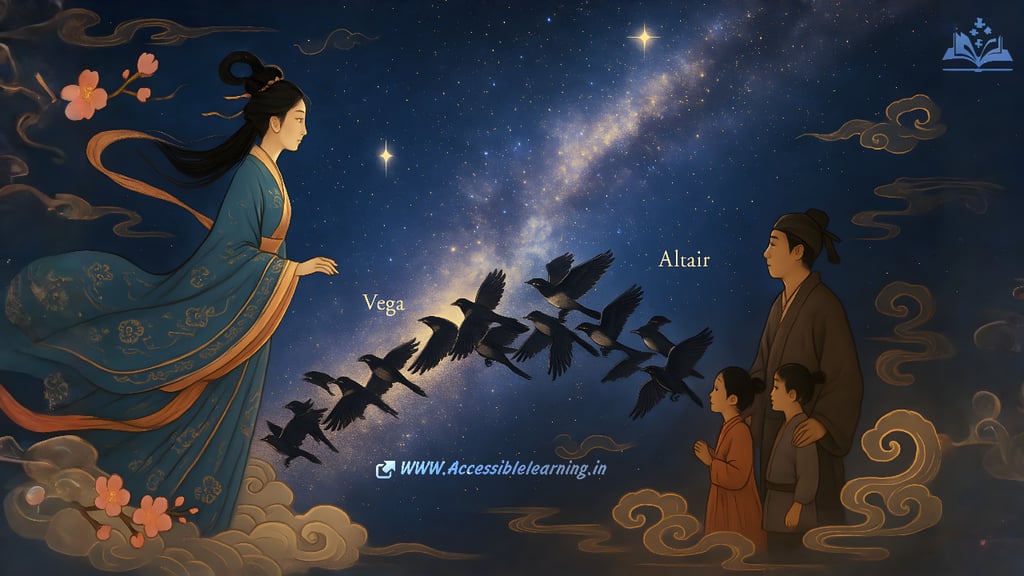
Qixi Festival: The Complete Guide to Chinese Valentine's Day
Explore Qixi Festival traditions, the celestial love story of the Weaver Girl and Cowherd, modern celebrations, and cultural significance in this guide.
CULTURE/TRADITIONEVENT/SPECIALCELEBRATION/FESTIVALSCHINESE HISTORYTRAVEL LIFE
Kim Shin
7/23/20257 min read


The Qixi Festival, known as Chinese Valentine's Day, stands as one of China's most romantic traditional celebrations. Observed on the seventh day of the seventh lunar month, this ancient festival transforms the night sky into a canvas of love, weaving together celestial mythology, cultural traditions, and modern romantic expressions. For over two millennia, Qixi has captured hearts across East Asia, representing the enduring power of love that transcends even the boundaries between heaven and earth.
The Legendary Origins: The Weaver Girl & the Cowherd
The foundation of Qixi Festival rests upon one of China's most beloved folktales, the story of Zhinü (織女), the Weaver Girl, and Niulang (牛郎), the Cowherd. This celestial love story begins with Zhinü, the seventh daughter of the Jade Emperor, known for her exceptional weaving skills and her creation of colorful clouds in the heavens.
Zhinü descended to earth and encountered Niulang, a humble cowherd who had been mistreated by his family. Their meeting sparked an immediate and profound love, leading to marriage and the birth of two children. However, their happiness was short-lived when the Jade Emperor discovered his daughter's earthly romance and commanded her return to heaven.
The separation devastated both lovers. Niulang, aided by his magical ox, attempted to reach heaven with their children, but the Queen Mother of the West created the Silver River (the Milky Way) to permanently separate the couple. Moved by their unwavering love and the tears of magpies who witnessed their plight, the Queen Mother eventually allowed them to meet once a year. On the seventh day of the seventh lunar month, magpies form a bridge across the Silver River, enabling the lovers' annual reunion.
Historical Development & Cultural Significance
The Qixi Festival traces its earliest recorded mentions to the Han Dynasty (206 BCE–220 CE), initially emerging as a celebration of women's domestic skills, particularly weaving and needlework. During the Tang Dynasty (618-907 CE), the festival evolved into a more romantic celebration, with poets and scholars composing verses about love and longing.
The Song Dynasty (960-1279 CE) marked a significant transformation in Qixi's cultural significance. The festival became increasingly associated with romantic love, moving beyond its origins as a celebration of feminine crafts. This period established many of the romantic customs that continue today, including the tradition of lovers making wishes upon seeing the Vega and Altair stars.
Throughout Chinese history, Qixi has served multiple cultural functions. It has preserved ancient astronomical knowledge, as the festival teaches people to recognize the Vega and Altair star systems. The celebration has also maintained traditional gender roles and expectations while simultaneously providing women with opportunities for social interaction and artistic expression.


Traditional Customs & Rituals
Stargazing & Celestial Observations
The most fundamental Qixi tradition involves observing the night sky to locate Vega (representing Zhinü) and Altair (representing Niulang) on opposite sides of the Milky Way. Families and couples gather outdoors to search for these stars, believing that clear skies indicate the lovers' happiness and that witnessing their celestial meeting brings good fortune to earthly relationships.
Needlework Competitions & Skill Demonstrations
Historically, young women participated in needlework competitions during Qixi, demonstrating their weaving, embroidery, and sewing abilities. These contests served both as entertainment and as opportunities for young women to showcase their domestic skills to potential suitors. Participants would thread needles by moonlight, create intricate embroidery patterns, and weave colorful threads into artistic designs.
Worship of Zhinü
Traditional Qixi celebrations included elaborate ceremonies honoring Zhinü as the patron goddess of weaving and women's crafts. Women would set up altars with offerings of fresh fruits, flowers, cosmetics, and needlework supplies. These rituals included prayers for improved domestic skills, successful marriages, and family harmony.
Garden Spider Divination
A unique Qixi tradition involved placing small spiders in containers and observing the patterns of their webs the following morning. Elaborate, symmetrical webs were interpreted as signs of exceptional needlework skills and future prosperity, while simple or incomplete webs suggested areas for improvement.
Modern Celebrations & Contemporary Adaptations
Commercial & Urban Celebrations
Contemporary Qixi Festival celebrations have embraced modern romantic customs while maintaining traditional elements. Chinese cities transform during Qixi week, with shopping districts, restaurants, and entertainment venues offering special promotions and romantic packages. Department stores create elaborate displays featuring traditional Qixi symbols alongside modern Valentine's Day motifs.
Digital Age Traditions
Social media platforms have revolutionized Qixi celebrations, with couples sharing romantic messages, photos, and videos using festival-specific hashtags. Online retailers capitalize on the occasion with flash sales, limited-edition products, and romantic gift bundles. Virtual reality experiences now allow people to "walk" across the magpie bridge and participate in digital stargazing events.
Gift-Giving Customs
Modern Qixi gift exchanges mirror Western Valentine's Day traditions while incorporating uniquely Chinese elements. Popular gifts include jewelry featuring magpie and star motifs, traditional handicrafts, romantic getaway packages, and personalized items celebrating the couple's relationship. Flowers remain central to contemporary celebrations, with roses maintaining popularity alongside traditional Chinese blooms like peonies and lotus flowers.
Regional Variations Across Asia
Taiwan
Taiwanese Qixi celebrations blend traditional Chinese customs with local innovations. The island's technology sector has created digital platforms for virtual Qixi celebrations, while traditional night markets offer special festival foods and romantic activities. Taiwanese couples often visit temples dedicated to Yue Lao, the god of marriage, seeking blessings for their relationships.
Hong Kong
Hong Kong's international character has produced a unique fusion of Eastern and Western romantic traditions during Qixi. The city's skyline provides a dramatic backdrop for stargazing events, while luxury hotels and restaurants create elaborate themed experiences combining traditional Chinese elements with contemporary international cuisine and entertainment.
Singapore & Malaysia
Overseas Chinese communities in Southeast Asia maintain Qixi traditions while adapting to multicultural environments. These celebrations often incorporate local cultural elements, creating festivals that honor Chinese heritage while reflecting the diversity of their adopted countries.


Qixi Festival Foods & Culinary Traditions
Traditional Festival Foods
Qixi culinary traditions center around foods that symbolize love, fertility, and skillful preparation. Qiaoguo (巧果), or "skillful fruits," are intricate pastries shaped like flowers, animals, and traditional symbols. These delicate confections demonstrate the maker's culinary abilities and serve as offerings to Zhinü.
Other traditional Qixi foods include colorful rice balls representing the stars, noodles symbolizing the threads that connect lovers, and fresh seasonal fruits arranged in artistic displays. Regional variations incorporate local specialties while maintaining the festival's emphasis on beautiful presentation and symbolic meaning.
Contemporary Culinary Innovations
Modern Qixi celebrations have expanded the festival's culinary repertoire to include elaborate romantic dinners, themed desserts, and fusion cuisine that combines traditional Chinese flavors with international romantic dining concepts. Restaurants create special Qixi menus featuring dishes with romantic names and presentations that reference the festival's legendary origins.
Economic Impact & Commercial Significance
The Qixi Festival has evolved into a major economic driver in China and other East Asian markets. Retail sales during the Qixi season compete with major shopping holidays, as consumers purchase gifts, clothing, cosmetics, and experiences. The festival's commercial impact extends beyond traditional retailers to include tourism, entertainment, and service industries.
E-commerce platforms report significant increases in sales of romantic gifts, luxury items, and experience packages during Qixi season. The festival has also sparked innovation in product design, with companies creating limited-edition items that incorporate traditional Qixi symbols and themes.
Cultural Preservation & Education
Academic & Cultural Institutions
Museums, universities, and cultural centers across Asia organize Qixi exhibitions and educational programs that explore the festival's historical significance, artistic traditions, and contemporary relevance. These initiatives help preserve traditional crafts like embroidery and weaving while educating younger generations about their cultural heritage.
International Recognition & Appreciation
The Qixi Festival has gained recognition beyond East Asian communities, with cultural institutions worldwide hosting celebrations that introduce international audiences to Chinese romantic traditions. These cross-cultural exchanges promote understanding and appreciation of Chinese culture while demonstrating the universal nature of love and romance.
Astronomical & Scientific Connections
The Qixi Festival maintains strong connections to astronomical observations and scientific education. The celebration provides opportunities to teach people about stellar navigation, constellation identification, and the cultural significance of astronomical events across different civilizations.
Modern astronomy has enhanced understanding of the Vega and Altair star systems referenced in Qixi mythology, allowing educators to combine traditional storytelling with contemporary scientific knowledge. Planetariums and observatories often host special Qixi events that blend cultural education with stargazing activities.
Comparison with Valentine's Day & Other Romantic Celebrations
While Qixi shares similarities with Western Valentine's Day, important distinctions reflect different cultural values and historical developments. Qixi emphasizes patience, loyalty, and the willingness to overcome obstacles for love, themes that resonate with traditional Chinese relationship ideals.
The festival's focus on skill development and personal improvement offers a unique perspective on romantic celebration, suggesting that becoming a better person enhances one's capacity for love and partnership. This educational aspect distinguishes Qixi from purely commercial romantic holidays.

Future Trends & Evolution
The Qixi Festival continues evolving as younger generations balance traditional cultural values with contemporary lifestyle preferences. Future developments likely include increased digital integration, environmental sustainability initiatives, and creative fusion of traditional and modern celebration elements.
Cultural preservation efforts focus on maintaining the festival's essential meaning while allowing natural adaptation to changing social conditions. This balance ensures that Qixi remains relevant and meaningful for future generations while honoring its ancient origins and cultural significance.
The Qixi Festival represents far more than a romantic holiday; it embodies the enduring power of love, the importance of patience and dedication, and the beautiful integration of mythology, astronomy, and human emotion. From its ancient origins in Han Dynasty stargazing to its contemporary celebration across digital platforms, Qixi demonstrates how traditional festivals can evolve while maintaining their essential cultural and spiritual significance.
As millions of people across Asia and around the world observe Qixi each year, they participate in a celebration that connects them to thousands of years of cultural heritage while creating new memories and traditions. The festival's emphasis on overcoming obstacles, developing personal skills, and maintaining faithful love offers timeless lessons that transcend cultural boundaries and speak to universal human experiences.
Whether observed through traditional stargazing and needlework or contemporary gift-giving and digital celebrations, the Qixi Festival continues to inspire people to reach across any distance—even the vast expanse of the Milky Way—for love.
Subscribe To Our Newsletter
All © Copyright reserved by Accessible-Learning Hub
| Terms & Conditions
Knowledge is power. Learn with Us. 📚


